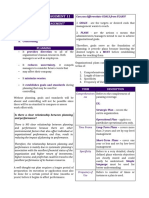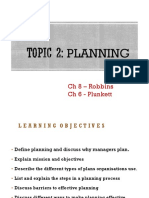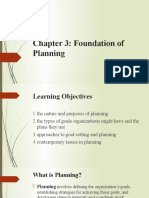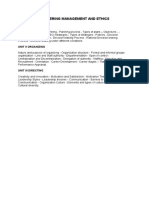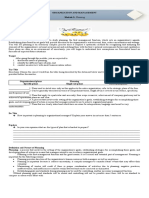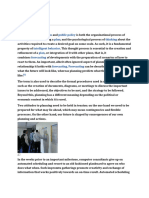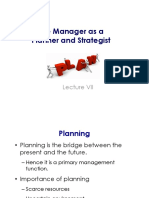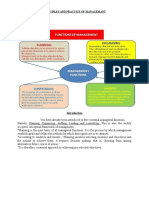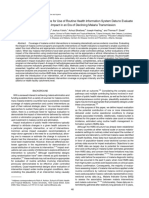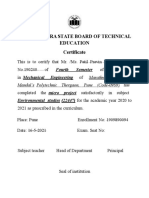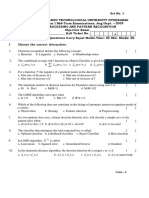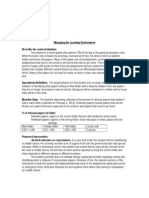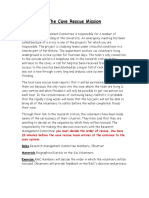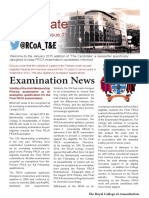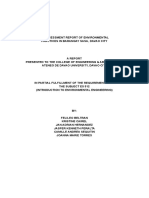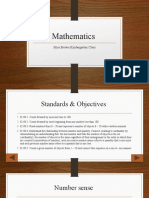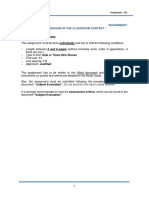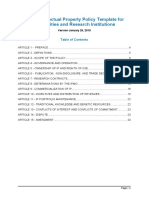ORGANIZATION AND MANAGEMENT
I-PREPARATION
CHAPTER 3 Activity
Lesson 1: PLANNING 1.What is your idea about Business Plan?
WEEK 3 ________________________________________________________
________________________________________________________
________________________________________________________
Learning Objectives
Discuss the nature of II-EXPLORATION
planning
Compare and
contrast the different
levels of the firm
Describe planning at
different levels of the
firm
apply appropriate
planning techniques
and tools
formulate a decision
from several
alternatives
Source : https://s3.amazonaws.com/mentoring.redesign/s3fs-
public/business-plan_4.jpg
Think?
oof m
What do these pictures represent? Why do you say so?
________________________________________________________
________________________________________________________
________________________________________________________
Page 1
�ORGANIZATION AND MANAGEMENT
III-FIRM UP
What is planning?
-a process that involves the setting of the organizations, goals, establishing strategies for
accomplishing those goals and developing plans for actions or means that managers intend to
use to achieve organizational goals.
-Is a logical and systematic approach of formulating the objectives, programs, policies,
procedures, budgets, rules and regulations, and other types of plans.
- Considered the most basic of all managerial functions. Without this, other functions of a
manager cannot be tackled efficiently and effectively.
-is the first management function and for good reason. It is a crucial and essential part of
management
-provides direction to all of the organizations human resources both managers as well as
employees.
GOALS –Are the targets or desired ends that management wants to reach.
PLANS-Are the actions or means that administrators/managers intend to use to achieve
organizational goals. In short, goals serve as the foundation of planning; goals precede plans
because knowing the desired targets is a must before establishing plans for reaching them.
NATURE OF PLANNING
1. Contribution to Purpose and Objectives – planning is required to facilitate
accomplishment of business purpose and objectives. This statement is taken from the
nature of organized business.
2. Planning as the First Basic Function – logically performed before the execution of all
other managerial functions. All managerial functions must be planned if they are to be
effective and efficient.
3. Planning as a Function of All Managers – the character and scope of planning will differ
from one authority to another.
4. Planning for Efficient Organization – evaluated by the amount it contributes to purpose
and objectives as offset
TYPES OF PLANS
1. STRATEGIC PLANS-Plans that establish the organizations overall goals and apply to
the entire firm: they are broad in scope and the responsibility of the CEO, presidents,
and general manager of the company
2. OPERATIONAL PLANS-Plans that apply to a particular unit area only: their scope is
narrow; achievement of company goals may not be achieved if operational plans are
not clear.
3. SHORT TERM PLANS-Plans that cover one year or less; such plans must lead toward
the attainment of long-term goals and are the responsibility of the unit/department
heads.
4. DIRECTIONAL PLANS-Plans that are flexible or gives general guidelines only; although
flexible and general, these plans must still be related to the strategic plans.
Page 2
�ORGANIZATION AND MANAGEMENT
5. SPECIFIC PLANS-Plans that are clearly stated and which have no room for
interpretation; language used must be very understandable
6. SINGLE-USE PLAN-Plans used or stated once only as this applies to the entire
organization; refer to the strategic plans of the firm
7. STANDING PLANS-Plans that are on-going; provide guidance for different activities
done repeatedly; refer to the identified activities of operational plans.
STEPS IN PLANNING
1. Define your goals/objectives by identifying desired outcomes/results in very specific
ways.
2. Determine where you stand in relation to set goals/objectives; know your strengths and
weaknesses.
3. Develop premises regarding future conditions ;anticipate future events ,generate
alternative “scenarios” for what may happen; identify for each scenario things that may
help or hinder progress toward your goals/objectives
4. Analyse and choose among action alternative most likely to accomplish
goals/objectives.
5. Implement the plan and evaluate results; take corrective action and revise plans as
needed
PLANNING TECHNIQUES AND TOOLS AND THEIR APPLICATIONS
1. Forecasting- is an attempt to predict what may happen in the future. All planning types
without exception make use of forecasting
2. Contingency Plans- must be prepared by managers, ready for implementation when
things do not turn out as they should be. Contingency factors called “trigger points”
indicate when prepared alternative plan should be implemented.
3. Scenario planning –planning for future states of affairs is a long term version of
contingency planning.
4. Benchmarking-is another planning technique that generally involves external
comparisons of a company’s practices and technologies with those of another
companies.
5. Participatory planning-is a planning process that includes the people who will affected
by the plans and those who will be asked to implement them in all planning steps.
Page 3
�ORGANIZATION AND MANAGEMENT
IV-ENRICHMENT
ACTIVITY 1 (list down)
Direction : Create and set goals or targets in your fast food business. List down possible future
changes in the fast food.
Activity 2 (SWOT ANALYSIS)
Direction: Write all the possible SWOT that you may be encountered in your fast food business
Page 4
�ORGANIZATION AND MANAGEMENT
V-ENRICHMENT
Direction : Explain your answer
1. Name at least five types of plans. Which, in your own opinion is the plan that is hardest to
prepare?
_______________________________________________________________________________
_______________________________________________________________________________
_______________________________________________________________________________
_______________________________________________________________________________
2. Name the five steps in planning. Is there a particular step that could be bypassed or
eliminated? Explain your answer
_______________________________________________________________________________
_______________________________________________________________________________
_______________________________________________________________________________
_______________________________________________________________________________
Page 5









